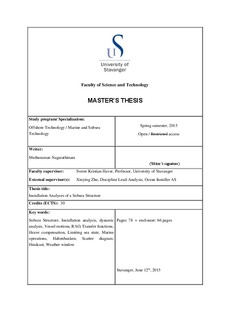| dc.description.abstract | A typical installation of a subsea structure with mono hull offshore construction vessel is studied. Focus has been on the vessel motions, lifting arrangement and the planning of this operation.
The behaviour of vessel motions are studied with the available transfer functions of the vessel at centre of gravity. The key transfer functions for Heave, Pitch and Roll are discussed when the wave propagates in head and beam seas. The transfer functions used are qualitatively verified for their correctness and usage in this study. Then, the heave motion at two different points far away from the CoG of the vessel are studied to see the difference in heave motion. Transfer functions at cranetip are derived, as this is the main excitation for the dynamics on the crane wire. The derived transfer function at the crane tip is verified against the results from SIMA software.
In the lifting arrangement study, transfer functions for the vertical motion of the suspended load are derived by assuming linear relationship between crane tip motion and motion of the mass. Then, using that transfer function, the transfer function for the dynamic tension on the crane wire is derived for the wave in head sea and beam sea. To improve the lifting arrangement system, the heave compensation system is introduced with a discussion about its efficiency.
To obtain the limiting sea state for this operation, a deterministic and a stochastic approach have been followed. In the stochastic method, JONSWAP spectrum is used for the total sea case which propagated in head sea and beam sea respectively. Then, combined sea spectrum i.e. double peak spectrum for the wind sea with head sea direction introduced and swell sea which here is simplified to always propagate between the direction of head and beam seas, is used to obtain limiting sea state accounting the effect of crossing sea approximately. Respective response spectrum is then derived based on linearity of the response and assumption that response of swell sea is not effected by the wind sea from a different direction and vice versa. The discussion is made about the comparison of the approaches followed to obtain the limiting sea state. Sensitivity study on the probability of exceedance of critical response is shown as well.
For planning of this operation, 60 years of hindcast data are used. The hindcast data taken are corrected based on the wind speed measurement available. And the discrete values of the spectral peak period in the data are uniformly distributed. After randomization of Tp, annual and monthly scatter tables of Hs and Tp, and plots have been produced to see the percentage of times available for a sea state during a year and monthly. Likewise, for Hs ≤ 2m, the average percentages of non-exceedance of this sea state are produced for various months. Since the scatter table do not give any info regarding the duration of the sea state, the average durations of sea state for Hs ≤1 m, 2 m, and 3 m are calculated. Then, since number of available windows are useful for planning an operation, the average number of windows available for Hs ≤ 2m, and duration 6, 12, 24, 48, 72 hours are screened through the hindcast data and presented. Finally, dividing an operation into smaller phases, here 72 hours operations divided into 48+24 hours, 24+24+24 hours, are studied and discussed about the change in percentage of successful operation and average number of days to complete that operation, in a month using the 60 years of hindcast data. | nb_NO |

